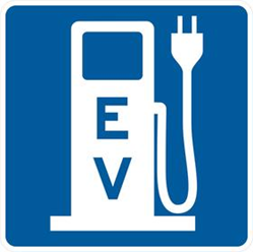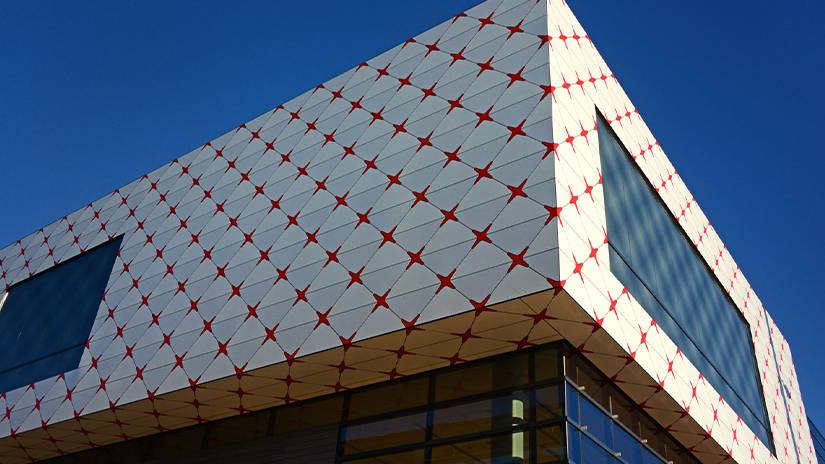Facilities
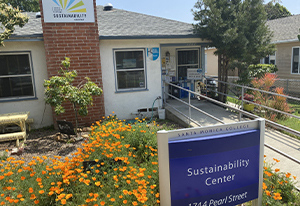 The Sustainability Center is a "Living Lab" for sustainable practices and green building
materials. It has been turned into an example of how an office can be efficient and
productive while also having a small footprint in terms of energy, water, and waste.
The Center houses the Student Greening Workshops, to teach students how to become
more sustainable in their personal and professional lives and is used by the eco-clubs
to meet and conduct academic research related to sustainability. The Center employs
student workers to promote zero waste and to run the Organic Learning Garden as well
as to hosts annual events such as Earth Week and community beach cleanups.
The Sustainability Center is a "Living Lab" for sustainable practices and green building
materials. It has been turned into an example of how an office can be efficient and
productive while also having a small footprint in terms of energy, water, and waste.
The Center houses the Student Greening Workshops, to teach students how to become
more sustainable in their personal and professional lives and is used by the eco-clubs
to meet and conduct academic research related to sustainability. The Center employs
student workers to promote zero waste and to run the Organic Learning Garden as well
as to hosts annual events such as Earth Week and community beach cleanups.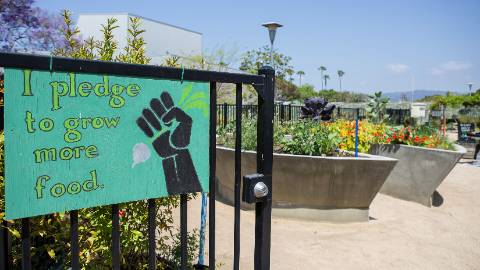 The Organic Learning Garden (OLG) provides the opportunity to learn, to grow our own
food, and better understand food systems and the impact they have on our society.
We can make our communities self-sustaining, have access to fresh and healthy food,
reconnect to the earth and our traditions, and nourish our bodies. The garden has
about 2,000 square feet of planting space using raised beds, containers, mounded beds,
and constructed herb gardens. Plots are assigned to groups of 6 or more students and/or
staff or a student can join Club Grow to have access to growing food together with
the club. The garden is student-run with several paid Garden Managers. To apply for
a plot or job, contact smc.clubgrow@gmail.com.
The Organic Learning Garden (OLG) provides the opportunity to learn, to grow our own
food, and better understand food systems and the impact they have on our society.
We can make our communities self-sustaining, have access to fresh and healthy food,
reconnect to the earth and our traditions, and nourish our bodies. The garden has
about 2,000 square feet of planting space using raised beds, containers, mounded beds,
and constructed herb gardens. Plots are assigned to groups of 6 or more students and/or
staff or a student can join Club Grow to have access to growing food together with
the club. The garden is student-run with several paid Garden Managers. To apply for
a plot or job, contact smc.clubgrow@gmail.com.
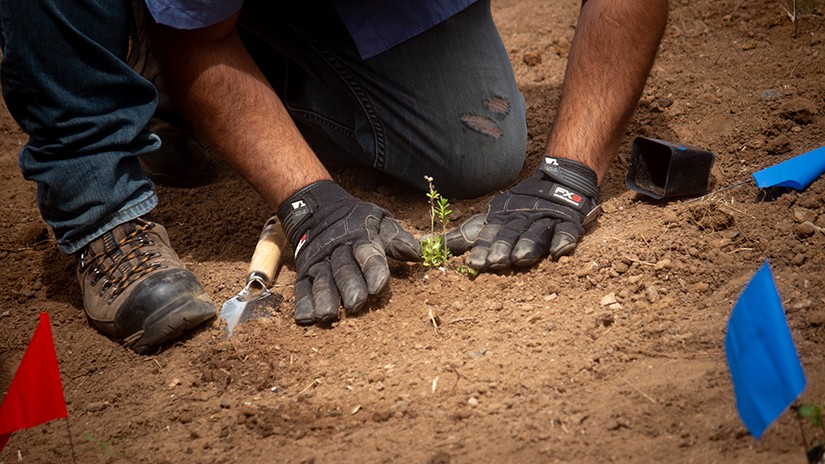
SMC has the first Micro Forest in the nation at a community college. Micro Forests are densely-planted, multilayered indigenous forests planted in small urban spaces which act as self-sustaining ecosystems, reconnect fragmented habitat and restore biodiversity. Plants are spaced in a way that reduces competition for sunlight, so each species can grow faster. SMC’s micro forest also provides research experience to biology students who study and track the growth and impact of the project. Benefits of micro forests—in a small footprint—include soil-building, capture of storm water, increased carbon sequestration, heat mitigation, provision of native habitats, biodiversity improvement, and more.
Made possible by funding from Malibu Foundation, the micro forest is located on the hillside by the entrance to parking structure 3 where there are signs describing each of the species of plants.
Since 2001 SMC has used a large composting system which houses about 400,000 worms
to convert about 500 lbs of food scraps, coming out of the cafeteria each week, into
valuable fertilizer. This nutrient rich soil is used on the landscaping around campus
by our Grounds department. By using this system, SMC processes 10,000 lbs of food
waste on our own property, which contributes in reducing methane emissions from decomposing
food waste and carbon emissions from the transportation of all that food waste to
distant landfills or compost facilities.
In 2009-10 the Board of Trustees passed a Zero waste Events Board Policy requiring
events to use compostable ware and produce no more than 10% waste. The Recycling program,
managed by our Recycling Specialist and student workers, has a collection plan for
compostables, recyclables, clean paper, cardboard, pallets, and toner cartridges.
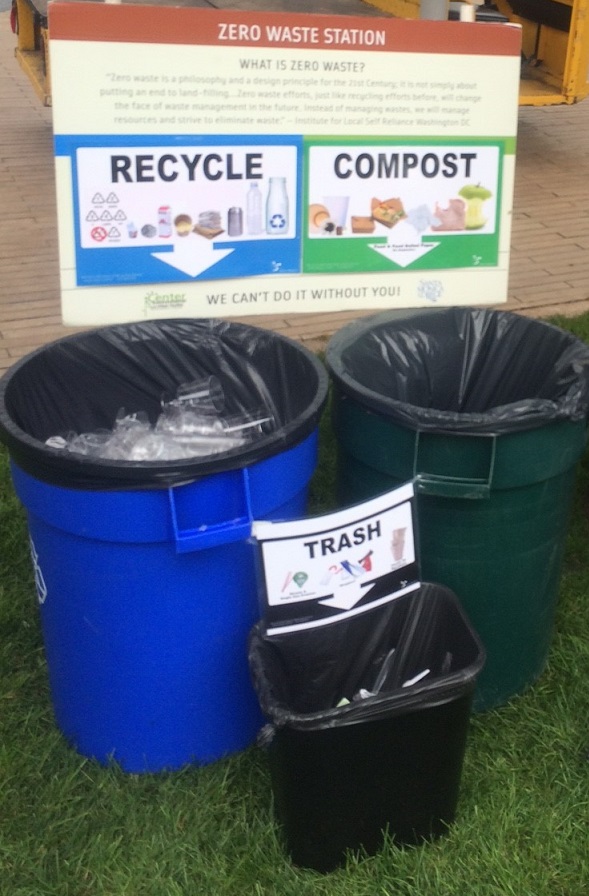
On-campus food vendors are selected using comprehensive sustainability criteria. This
resulted in Carl's Jr. being replaced with Campus Kitchen, which has robust environmental
business practices and healthier choices. Vendors now are more supportive of SMC's
recycling, composting and Zero Waste events policy.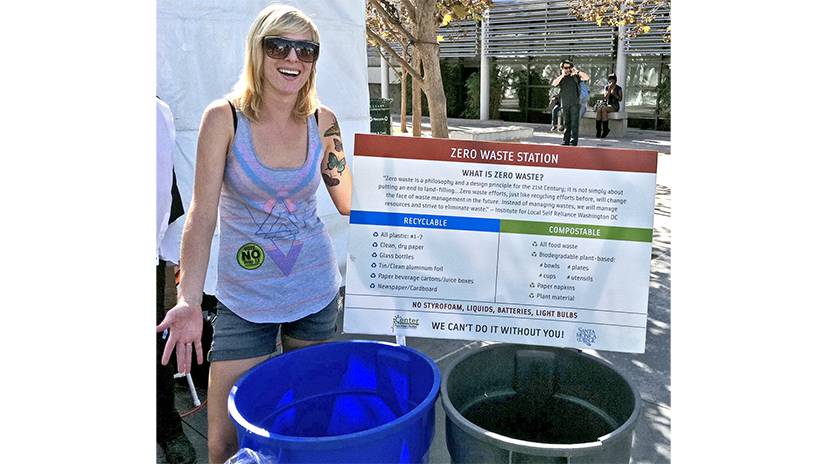
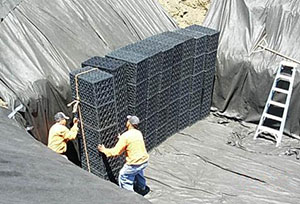 SMC’s policy is to retain as much stormwater on campus as possible. When it rains,
75,000 gallons of water are channeled to the quad where it drains down under the grass
through layers of gravel and permeable cloth into this swimming pool-sized cistern.
The gravel and permeable cloth provide the first layers of filtration into the holding
tank (cistern). The water then slowly drains out of the cistern through the many layers
of rock and sediment, thereby purifying the water to recharge the aquifers and retain
rainwater.
SMC’s policy is to retain as much stormwater on campus as possible. When it rains,
75,000 gallons of water are channeled to the quad where it drains down under the grass
through layers of gravel and permeable cloth into this swimming pool-sized cistern.
The gravel and permeable cloth provide the first layers of filtration into the holding
tank (cistern). The water then slowly drains out of the cistern through the many layers
of rock and sediment, thereby purifying the water to recharge the aquifers and retain
rainwater.
A smaller 2,200 gln cistern, under the Organic Learning Garden, captures rainwater which is pumped up and used for irrigation. It's healthier for the fruits and vegetables since it does not contain chemicals like fluoride, chlorine or chloramine. Together, SMC's cisterns are capturing over 200,000 gallons of rainwater during each event.
Drought tolerant landscaping is found throughout many areas of campus. They support local wildlife, requires little maintenance and very little water. Some plants are endangered and some have benefits to the local ecosystem like feeding local bees and being fire resistant.
The Sustainability Center is planted with native species and each plant is marked
for reference. Mulch has been spread throughout the yard to capture valuable runoff
from rain events to help return it to the aquifer. Rain barrels capture water from
the roof which can be used during dry days to water the landscape.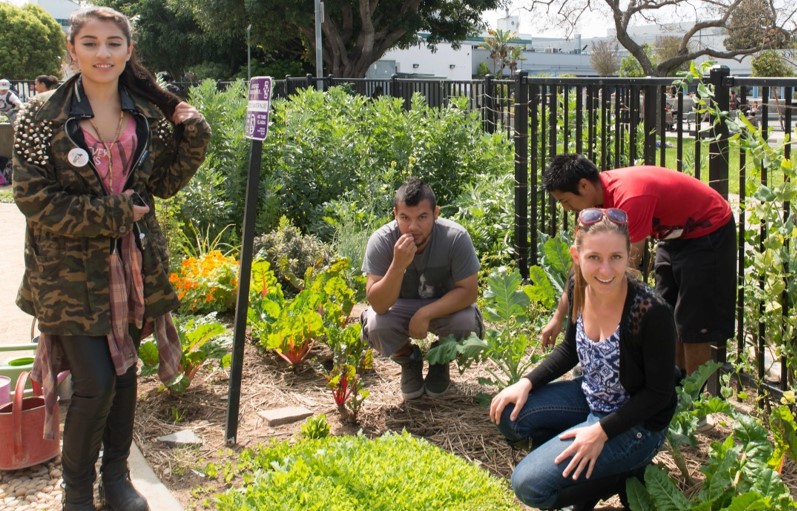
SMC Bond Measure Building Projects are to be designed to meet the LEED (Leadership in Energy and Environmental Design) rating system, a widely recognized national and international benchmark for design, construction and operation of high performance buildings. The LEED rating system provides a measurable way to incorporate sustainable design into the built environment.
Some of the distinguishing characteristics and features of a LEED building include:
- Storm Water Quantity and Quality Control using underground cisterns
- Water Use Reduction using low water technologies
- Water Efficient Landscaping
- Optimization of Energy Performance through lighting controls
- On-Site Renewable Energy production through photovoltaic array
- Construction Waste Management Control
- Recycled Content of construction materials
- Use of Certified Wood products
- Low Emitting Materials, Adhesives, and sealants, and Paints and coatings
- Indoor Air Quality Control
- Thermal Comfort Control
- Daylighting and Views
The following buildings have been certified using LEED:
Student Services Building is designed under USGBC NC v3 and is seeking a LEED Platinum certification.
CORE Performance Center is designed under USGBC NC v3 and is certified LEED Platinum.
Center for Media and Design is designed under USGBC NC v3 and is certified LEED Gold.
Performing Arts Center is designed under USGBC NC v3 and is certified LEED Gold.
IT / Media Building has been designed under USGBC NC v3 and has a LEED Silver Certification.
HSS Building is certified LEED Silver. 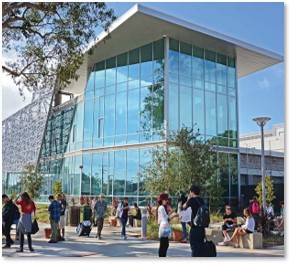
One of our 4 institutional learning outcomes is directly related to sustainability:
"SMC students will take responsibility for their own impact on the earth by living
a sustainable and ethical life style." We are the only community college in the nation
to have an Ecological Literacy component as part of our graduation requirements. SMC
also developed the Solar/Photovoltaic Installation certificate, Energy Efficiency certificate, and Recycling and Resource Management certificate. The Two Environmental AA & AS degrees offered at SMC are Environmental Studies and Environmental Science. Many
traditional disciplines have “greened the curriculum” by incorporating environmental
themes and examples and/ or offering the Student Sustainability Workshops as extra
credit.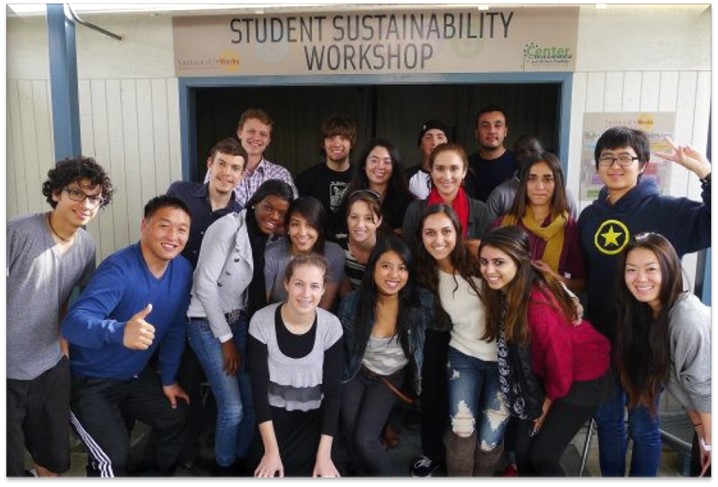
779 KW of photovoltaic electricity is provided by panels found in various places around
campus, including Parking Structures 3 and 4, the Library, the Sustainability Center,
the Center for Media and Design, and the Student Services Center (SSC). In the middle
of the day the SSC, our largest building on campus, produces 75% of it's own electricity
using solar. 
Solar Thermal - Solar water panels collect heat from the sun to provide hot showers in the CORE Performance Building, to avoid burning gas as the heat source.
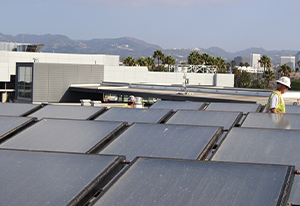
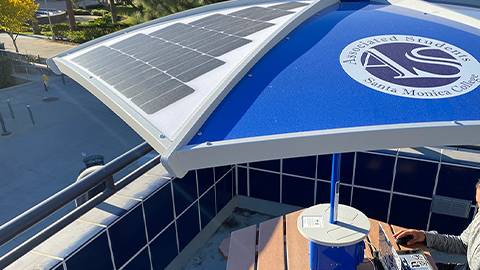
Solar umbrellas can be found on the 2nd story deck of the Cayton Center were students can charge their phones and laptops day and night, thanks to solar panels that charge batteries on these two unique shade umbrellas. This initiative not only provides
convenient charging stations, but serves as a hands-on demonstration of practical solar energy applications, fostering a greater appreciation and understanding of the renewable energy among students
There are 17 water stations, with filters, located around campus to easily refill
water bottles. When available, the Associated Students provide free reusable bottles
to students.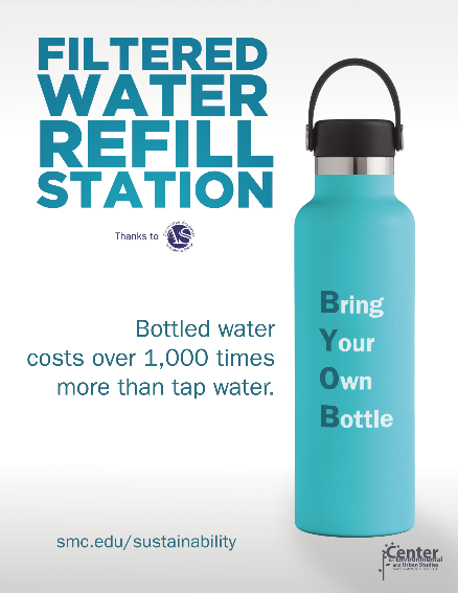
High efficiency boilers installed in:
- Drescher Hall – 95% efficiency condensing boilers
- Science Building – 95% efficient boilers
Lighting fixtures upgraded out of 16,000 total
- Interior fixtures – 9905
- Exterior fixtures – 773
- Occupancy sensors – 700
- Any fixture above 50 watts was targeted
- Occupancy sensors and time clocks installed to reduce lighting
Energy Management Systems to monitor and regulate building energy, temperature, and water use were installed
in 2017.
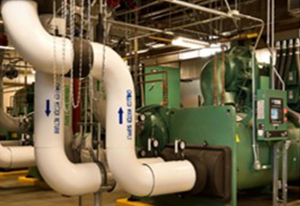
Two Central Plants have been installed in the CORE performance building on main campus and the CMD campus. They use chillers to freeze liquid in off-peak hours and then use the chilled water as refrigerant during the day to provide cooling to all buildings on the main campus. These systems provide energy efficiency by centrally cooling, using off-peak electricity, and by replacing harmful CFS (a powerful greenhouse gas) with chilled water as a refrigerant.
- Hazardous Waste Safety Officer position created.
- Green Seal Certified chemicals used campus-wide.
- Irrigation Specialist position created.
- TCBY/ The Coffee Spot is Green Business certified.
- The Bookstore is Green Business certified.
- Facilities use a fleet of electric carts on campus.

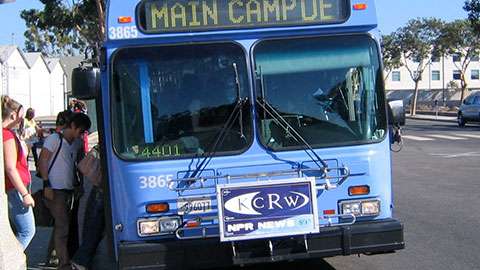
In addition to unlimited transit rides for students and employees, there are over 500 bike racks located throughout main campus, DIY bike stands, repair tools, and pumps are located in the bike lot on Peart Street, and are available 24/7. SMC has been recognized as a "Bike Friendly University"-Silver level by the League of American Cyclists. In 2023 SMC was recognized by the City of Santa Monica with a Platinum Achievement Award for it's transportation initiatives.
Since 2007 SMC and the Associated Students partnered with the Big Blue Bus to provide
unlimite
d rides to students who pay their Student Benefits Fee. The program, now called GoPass,
has expanded to include Metro buses and trains as well as a dozen other transit agencies
throughout LA County (with no fee to transfer bet
ween them). Students who participate can save over $400 per year on transit costs.
Main Campus - Student Services Center. There are 6 level II charging stations on the first floor for students and 6 on each of the two floors below for employees. There are also 21 spaces designated for EVs and ZEVs for staging before and after charging.
Main Campus - Lot 3 has 6 EV spaces on the bottom level drivers with their own cords. (2 for Students and 4 for Employees)
Bundy campus has 5 level I charging stations in the eastern parking lot.
CMD campus has 8 level II charging stations. (2 for Students and 6 for Employees)
Malibu campus has 4 level II charging stations.
EV charging stations will be integrated into each new future parking garage that is
constructed.